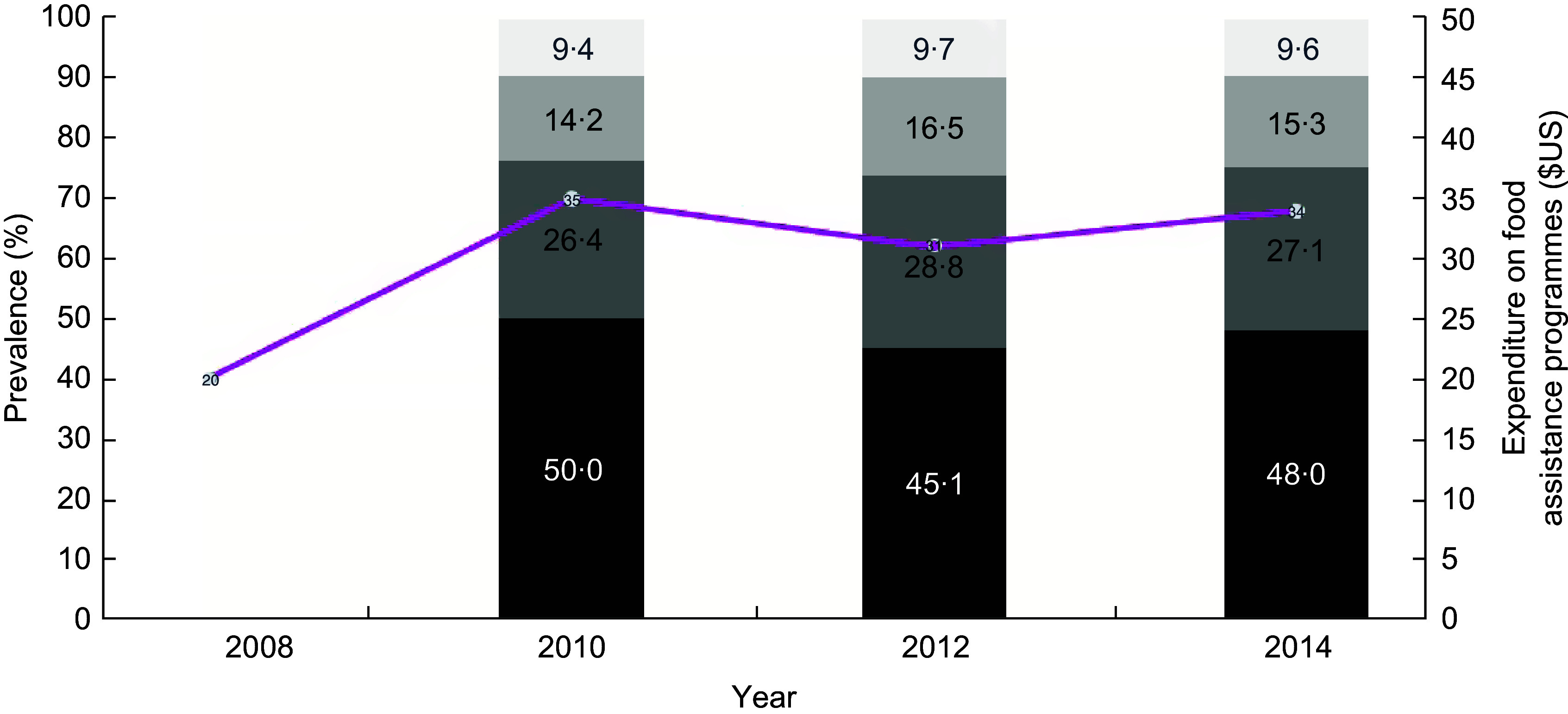Fig. 1.

Comparison of the prevalence of food security/food insecurity ( , food security;
, food security;  , mild food insecurity;
, mild food insecurity;  , moderate food insecurity;
, moderate food insecurity;  , severe food insecurity) and the Mexican government’s expenditure on food assistance programmes (
, severe food insecurity) and the Mexican government’s expenditure on food assistance programmes ( ), 2010–2014. The graph suggests that additional expenditures in food assistance programmes do not yield considerable reductions in food insecurity. In 2008, the total per capita expenditure in food assistance programmes was $US 20 (constant pesos 2010, $US 1 = $MX 18·64). By 2010, the government expenditure in these programmes increased up to $US 35, then it decreased to $US 31 in 2012, and then recovered to $US 34 in 2014. However, the prevalence of moderate food security at the household level, using the Latin American and Caribbean Food Security Scale (ELCSA), increased in 2012 by 2 points and severe food insecurity remained stable at 9 %. The ELCSA was not gathered in 2008. Nevertheless, similar results were obtained when food insecurity was estimated with the Mexican Food Security Scale (EMSA), the scale used by the official multidimensional poverty measure; whereas food security increased from 57·0 % in 2008 to 60·5 % in 2010, moderate food insecurity remained stable and severe food insecurity increased during the same period from 8·4 to 9·9 %. (Source: our own estimates using the National Household Income and Expenditure Survey (ENIGH) 2010, 2012 and 2014, and the National Council for the Evaluation of Social Policy (CONEVAL) inventory(25,28))
), 2010–2014. The graph suggests that additional expenditures in food assistance programmes do not yield considerable reductions in food insecurity. In 2008, the total per capita expenditure in food assistance programmes was $US 20 (constant pesos 2010, $US 1 = $MX 18·64). By 2010, the government expenditure in these programmes increased up to $US 35, then it decreased to $US 31 in 2012, and then recovered to $US 34 in 2014. However, the prevalence of moderate food security at the household level, using the Latin American and Caribbean Food Security Scale (ELCSA), increased in 2012 by 2 points and severe food insecurity remained stable at 9 %. The ELCSA was not gathered in 2008. Nevertheless, similar results were obtained when food insecurity was estimated with the Mexican Food Security Scale (EMSA), the scale used by the official multidimensional poverty measure; whereas food security increased from 57·0 % in 2008 to 60·5 % in 2010, moderate food insecurity remained stable and severe food insecurity increased during the same period from 8·4 to 9·9 %. (Source: our own estimates using the National Household Income and Expenditure Survey (ENIGH) 2010, 2012 and 2014, and the National Council for the Evaluation of Social Policy (CONEVAL) inventory(25,28))
